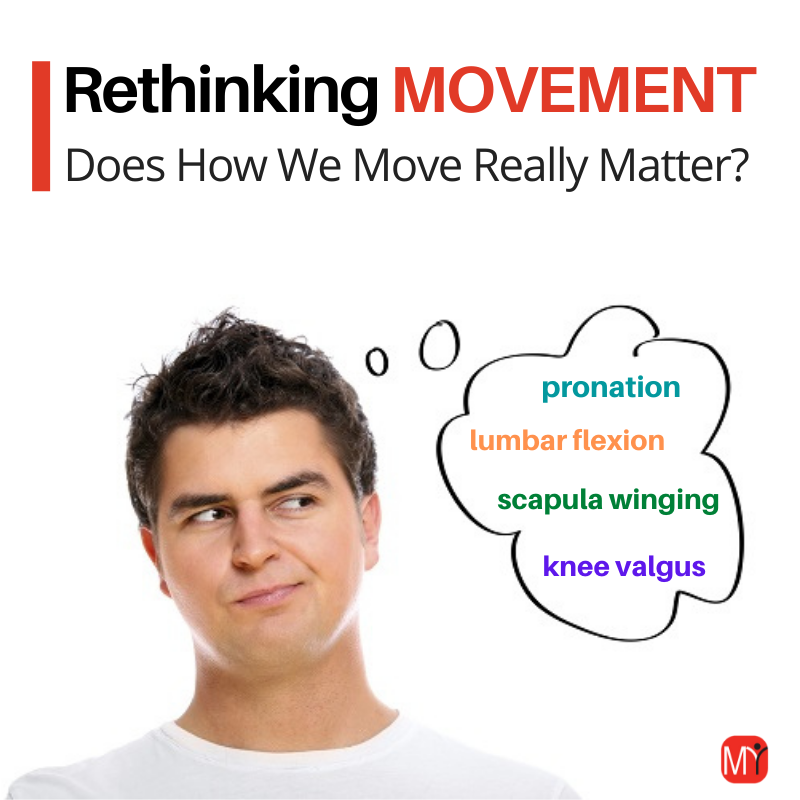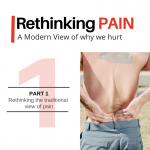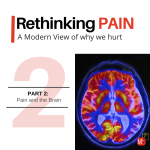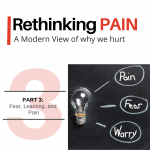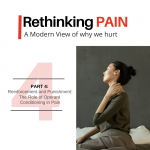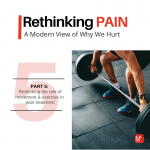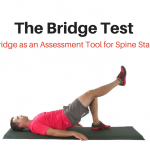There is a widely held belief that faulty movement patterns are a significant source of musculoskeletal pain and injury. The idea here is that improper joint motions put excessive stress on tissues that have trouble handling such a load. Over time the tissue breaks down leading to injury. Clinicians subscribing to this view hold that improving and correcting these faulty or compensatory movement patterns is a critical and necessary part of care.
On the surface this model may seem appealing. Even logical. But there are several problems with this line of thinking.
Perhaps the biggest and most glaring issue is agreeing on what these so-called “faulty” movements are. Is there a best or right way to move? Or do the variety of movement patterns and strategies seen across patients simply reflect the complex, adaptive, biological system that is our body?
But there’s another elephant in the room. One that’s pretty tough to ignore. That’s the fact that research has failed to find consistent support for the relationship between these “faulty” movement patterns and pain.
Do Faulty Movement Patterns Really Cause Pain or Injury?
We reviewed this topic in much greater detail in our Rethinking Pain article series, so the interested reader can dive into this a little more there. But to briefly summarize, when looking at prospective studies (remember these are the studies that follow a bunch of healthy people across time to see who develops a certain condition and who don’t) we really don’t see a consistent or predictable relationship between these so-called faulty movement patterns and who gets injured.
Failure of pathoanatomical or movement-based models has lead clinicians to search for other frameworks to guide treatment. Most recently clinicians and researchers have advocated the biopsychosocial or cognitive-behavioral models to help understand and to guide the treatment of pain.
These models are attractive as they take into account the multi-dimensional nature of pain. They recognize pain is not always about tissue damage or injury, but is often more about the brain’s processing and interpretation of the state of the body and the world around it. (Again, we covered this in detail in our Rethinking Pain series).
These models still view movement and exercise as critical factors in the treatment of pain. But here it is thought to be less about how we move and more about building tolerance. Both on a tissue level as well as a neurological one. The idea here is to build more resilient tissue, but also to teach the brain that movements can be safe and non-threatening.
But Movement Still Matters
On one hand I think this is good thinking. There is powerful messaging here. The human body is resilient and adaptable. But on the other hand I am not quite ready to completely abandon the notion that how we move matters.
But perhaps we need to look at the relationship between pain and movement from a different angle. Maybe it’s not that we need to move in an idealized way. Instead, maybe it’s more that we need to strive towards developing a more adaptable system that is able to move and respond in a wider variety of ways.
This is the concept of movement variability.
Movement Variability
Most routine movements are complex and involve the coordinated positioning of multiple joints and body segments. Think of bending forward to pickup a box. This involves the ankles, knees, hips, intervertebral joints, scapulothoracic joints, and elbows.
But notice how there are various joint configurations that can be utilized to accomplish the task (see figure 1). The traditional view has been that certain patterns of movement are more desirable than others. As if they represent more skilled or safe movements that have been learned and refined over time.
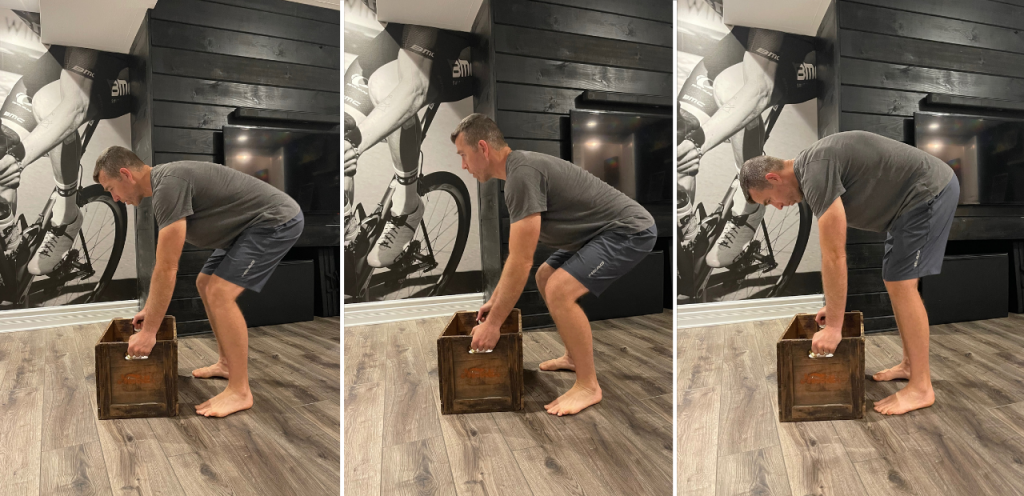
But here’s the thing.
Movements will naturally vary from repetition to repetition. Even with repetitive activities like bending, running, and walking the positioning of body segments will vary from cycle to cycle. If you were to take a snapshot of the leg across ten consecutive running strides you would see a slightly different joint configuration in each picture. Likewise EMG readings would demonstrate different patters of muscle contraction. These differences are termed “movement variability”.
There was a time that this variability was considered undesirable. From a motor control perspective it was viewed as system noise. A characteristic that was expected to reduce as the system learns to control unwanted motion in the kinetic chain.
But this view is changing.
More is Better
Like other physiological responses such as heart rate, greater variability with repeated movements is now understood as a positive attribute. A characteristic of a healthy and adaptable system that is able to respond to a multitude of stresses and to changes in movement and environmental demands (Latash 2012).
Movement Variability and Injury
Take knee pain for example. Here studies have failed to find a consistent relationship between lower extremity kinematics and knee conditions such as PFPS. But these studies typically look at peak or mean measurements of joint angles or segmental positions.
Instead of following this traditional approach, Hamill et al. (1999) looked at the variability of joint coupling between the thigh, tibia, and foot during running. Using this convention the authors reported consistently greater movement variability in healthy runners versus those with PFPS.
In a similar study comparing subjects with unilateral PFPS, Heiderscheit et al. (2002) reported reduced variability in stride length and thigh-leg rotation between the injured and healthy limbs within subjects, as well as reduced variability between the injured limb and that seen in healthy runners.
Similar findings of reduced movement variability have been shown in ACL injuries (Georgoulis et al. 2006), neck and shoulder pain (Lomond and Cote, 2010 & 2011), and lower back pain (van den Hoorn et al. 2012, Falla et al. 2014).
So with respect to pain and injury, it’s not that we need to move the right way. Instead, it appears to be more important that we are able to move in a wide variety of ways. It’s more about having movement options and being able to utilize different solutions to solve the same movement problem.
With Movement we NEED Options
Remember movement variability is dependent upon the degrees of freedom associated with the movement task. Recall our forward bending example from above. Because the task involves multiple body segments, it provides various combinations of joint positioning that can be utilized to accomplish the task.
In other words, the motor system can utilize different solutions to accomplish the same movement task.
But to express this variability each joint segment in the kinetic chain must be functioning properly. If any of the individual segments are limited by muscle weakness, poor motor control, or limited flexibility it will affect how the motor system is able to respond. It limits the movement options available to the system and results in more narrow, repeatable movement patterns.
Cognitive-Behavioral / Brain Factors
And it’s not just mechanical factors that come into play here. In cases of longstanding pain cognitive-behavioral factors such as fear of movement or beliefs that pain represents tissue damage may also restrict available movement options.
This relates back to the purpose of pain. From an evolutionary perspective, pain is a powerful driver of behavior. (Again, see our Rethinking Pain series.) If the brain understands a situation as threatening or potentially threatening it can call upon the pain system as a means to modify behavior. Full avoidance of the feared activity is one possible response, but modifying the movement pattern is another. This would reduce load on the threatened tissue while maintaining function.
Support for this idea is found in studies comparing movement variability in acute versus chronic pain. Here we see increased movement variability with acute experimental pain, but reduced variability and a more narrow movement patterns with chronic pain (Madelaine 2008a).
Greater variability in the initial stages of pain and injury is presumably an attempt by the motor system to explore potential movement options which would allow the CNS to maintain function while minimizing stress on the affected tissue. Over time the CNS then adopts the movement pattern that most successfully achieves this goal, thus leading to reduced variability.
These more narrow motor responses may be helpful in the short term to allow injured tissue to heal. But they are likely to be detrimental to musculoskeletal health in the long term as they limit the adaptability of the system.
Compensations Are Not Bad
Restriction or dysfunction at one joint affecting movement at another area is often referred to as a “movement compensation”. Personally, I don’t like this term because it gives the impression that the compensated movement is a negative thing. That we need to correct this compensation because it is a harmful or dangerous way to move.
But I think this is the wrong way to look at things. I think the body’s ability to utilize an alternative movement strategy that allows it to maintain function despite other problems is representative of an amazing, adaptable system. From an evolutionary perspective this ability to “compensate” has allowed us to adapt, survive, and get to where we are as a species.
But I do think problems can occur when these “compensations” become the only way the body is able to move. When joint dysfunction starts to accumulate and the movement options available to the system become too limited. This is when the body gets stuck in the same repeated movement patterns and loses the ability to move in varied and adaptable ways.
How Does Variability Affect Treatment
So when it comes to pain I think how we move does matter. But hopefully what is clear from the discussion so far is that we’re not trying to fix faulty movement patterns or get everyone to move in a specific, idealized way. We are trying to build a more adaptable system and give the body movement options. To do this we need to get each joint segment moving and working as good as possible.
With a lower back pain patient that demonstrates tight hamstrings or limited hip flexion, I want to target these deficits. Not necessarily because they are causing compensatory lumbar flexion, but simply because a hip is supposed to flex. And if it can’t it limits the movement options available to the system.
So keep it simple. If the hip is weak get it stronger. With a restricted ankle explore options to improve flexibility. If there is poor control of the lumbar spine address this. View the system through the lens of adaptability.
The whole is greater than the sum of it’s parts. But good parts are still needed to form a better whole.
Will this fix all the issues. Of course not. Pain is complicated and is influenced but a lot of variables. Sometimes you also need to address maladaptive beliefs with targeted pain education. Factors like stress, depression, anxiety, and medical co-morbidities will often play a role as well. But how you move still matters. After all, “bio” is an integral part of the the biopsychosocial model.
References
Falla et al. (2014). Reduced task-induced variations in the distribution of activiy across back muscle regions in individulas with low back pain. Pain. http://dx.doi.org/10.1016/j.pain.2014.01.027
Georgoulis et al. (2006). A novel approach to measuring variability in the anterior cruciate ligament deficient knee during walking: The use of the approximate entropy in orthopaedics. J. Clin. Monit. Comput. 20,11–18.
Hamill et al. (2014). A dynamical systems approach to lower extremity running injuries. Clinical Biomchanics, 14, 297-308.
Heiderscheit et al. (2002). Variability of stride characteristics and joint coordination among individuals with unilateral patellofemoral pain. J. Appl. Biomech. 18, 110–121.
Latash, M. (2012). The Bliss of Motor Abundance. Exp Brain Res. 217 (1): 1-5.
Lomond & Cote. (2010). Movement timing and reach to reach variability during a repetitive reaching task in persons with chronic neck/shoulder pain and healthy subjects. Exp. Brain Res. 206, 271–282.
Lomond & Cote. (2011). Differences in posture-movement changes induced by repetitive arm motion in healthy and shoulder-injured individuals. Clin. Biomech. 26, 123–129.
Madeleine et al. (2008) Changes in the degree of motor variability associated with experimental and chronic neck–shoulder pain during a standardised repetitive arm movement. Exp. Brain Res. 185, 689–698.
van den Hoorn et al. (2012). Mechanical coupling between transverse plane pelvis and thorax rotations during gait is higher in people with low back pain. J. Biomech. 45, 342–347.

